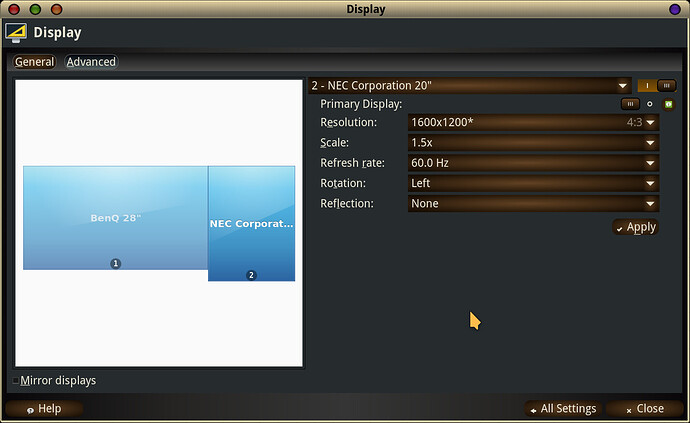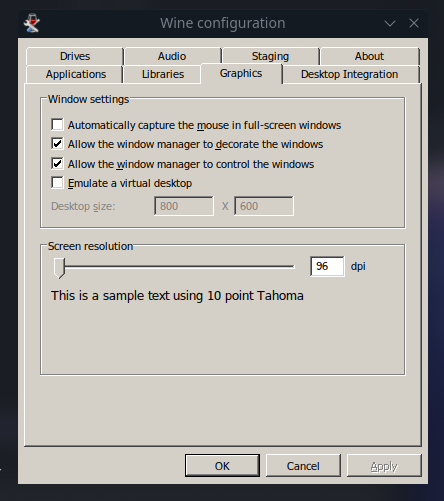Hello!
I am a newbie in EOS, but I have been using Debian for almost twenty years. I wanted to have a rolling release desktop system and decided to try EOS. This far I have been very happy! My conclusions is that for desktop Linux, a rolling release is the only possibility and Debian is not good for that.
I must, however, confess that all Linux desktops really suck in HiDPI. I have a 4K laptop and none of the desktops work 100% in scaling. Either the scaling is stupid 200% enlargement or it is not consistent across UI elements and applications. I have tried almost all possible desktop variations and none of them is perfect. I got XFCE running ok, but still any time now something may appear as microscopic small (Wine, Steam etc.) or some window decorations are of wrong size.
Kari
Out of mature DEs i advice to try KDE, it’s best in that front so far (as long as you set global scaling in it’s settings, not auto-detect from start)
I’m very happy with my 5120×1440 dual monitor setup. I don’t need a higher resolution, because I’m myopic (eyes with built-in anti-aliasing  ).
).
I don’t use any scaling, that’s awful. I keep everything at 100% and I just use bigger fonts. I use KDE Plasma, btw.
I couldn’t agree more, high dpi sucks on Linux when using a 4 k laptop with monitor of different resolution. Then there are gtk apps that scale differently than qt apps or icons. Gosh it’s painful. Nonetheless, I had the best experience on gnome strangely via Wayland. Then there are minor manual patches to scale qt and gtk consistently.
Welcome to the forum! ![]()
Here a couple of links and solution s to my troubles:
You may have already discovered most of the ‘tips’ I put in here (for XFCE) but if not you might benefit from a look here:
I run a 4K monitor, and a 1200x1600 20" secondary - and I scale the secondary up to match the physical size of windows in both. It works surprisingly well, although QT can be tricky to match up properly with GTK. I have always found it to be quite usable though.
Hope this helps - and if I missed anything in the Wiki, feel free to ask!
xfce is not the best choice for hidpi support.
In general, my experience with Linux isn’t that “hidpi” support is bad. It is that fractional scaling support is bad. The trick is don’t use fractional scaling. If you want something smaller than 200%, use font scaling. Font scaling will scale most UI elements in most DEs(Not sure about xfce).
That being said, hidpi isn’t perfect in most OSes. I have been trying to use it in Windows and it is a mess. Some applications just don’t scale or scale only certain elements I making them unusable.
Thanks! Your article has been an important source. The biggest problem of XFCE is that the styles are bound to the resolution and there are very few high DPI styles available. I think this binding to the resolution is a design mistake. There should be a mechanism for automatic scaling.
xfce development moves very slowly. I wouldn’t expect many design or architectural changes.
Just bookmarked this one, thanks!
Did I miss that in the Wiki? There is a scaling factor capability in Settings, it is just that the logic is backwards! A typical usable setting would be 0.7 (to scale by approx 1.5X the original size). Personally, I use 1.5 to shrink window sizes on my second monitor…
One way or another, you should be able to get what you want - it just takes more steps for many setups!
Just in case, here is the screenshot for my setup in Settings/Display:
where you can see the secondary monitor, the 1.5 entry for scale, and the rotation left. Remember - the scaling goes fractional too (under Custom), as well as the entries for 1.5 and 2 etc.
But scaling on xfce is set for both monitors at the same time correct? No individual monitor scaling. I thought that works only on gnome Wayland and cinnamon.
Nope - at the top you can see that the monitor selected is the secondary one… I use no scaling on the main 28 incher (just font sizing and so on (see wiki)).
Ok will have to try that again. As I recall that didn’t work on laptop plus external monitor, it always scaled both. But that was last year that I tried.
Yeah - this came in with 4.16 I think (6 months?) Anyway, it is now one of the better, if odder ways of handling things 
I just have to swap in a nocsd package, and all is good…
I used to have a 3k laptop (X1 Carbon) and Cinnamon was fantastic on it fwiw.
Welcome!
Cinnamon was easily the best at scaling and I used it a while until I learned how to deal with XFCE (and XFCE improved). Wayland WILL be good at it too, I think, when it can handle the rest of the things that it needs to…
I have found Cinnamon to handle HiDPI the best.
Actually, I just installed cinnamon. It can do fractional scaling and differential scaling on xorg (normally only works on Wayland, I.e. gnome to my knowledge). For example I have a 4k laptop hooked to a 1080dpi monitor, under display settings one can normally only scale double. However, there is a settings tab on top to switch on fractional scaling, one can then scale the external monitor to 100% and the 4 k screen to double scaling.
I use now KDE Plasma/XOrg. It seems to handle quite well scaling with a factor of 2.5 (2 is too small). I tried also Wayland, but the scaling went wrong. Also Wine and some other apps cannot handle scaling at all.

